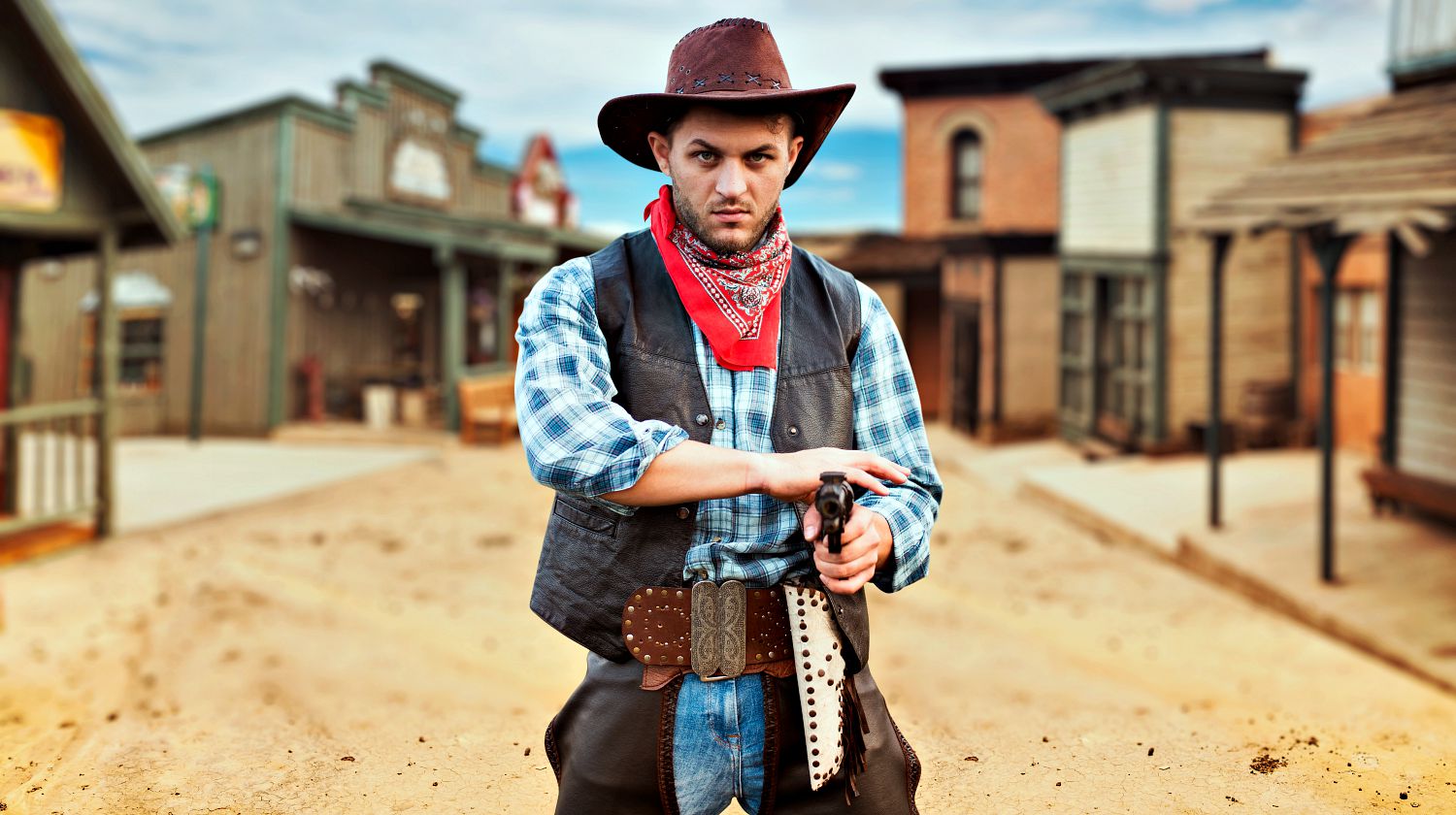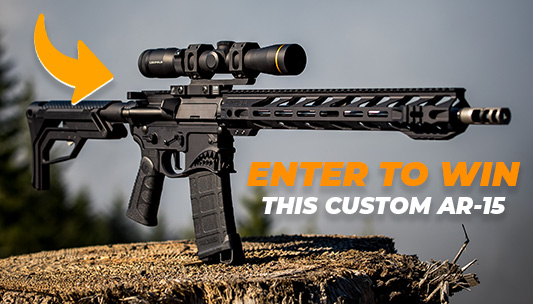Personal Safety
The Real Science Behind A Gunfight
Published
2 years agoon
By
Gun Carrier
What really happens during a gunfight? Learn more about the science of it here!
RELATED: Shooting Fundamentals
In this article:
- Gunfights in Film vs Real Life
- Preparing for a Gunfight
- Dynamics of Gunfighting
- Learning the Science Behind Gunfights
- Acting on Instinct
What Really Happens at a Gunfight
Gunfights in Film vs Real Life
Gunfight!
What do you see when you hear that?
The fictional version of what we conjure up in our mind when we hear the word “gunfight,” for most people anyway, comes from what movies and television would like us to believe.
That a “gunfight” is simply two Old West gunfighters squaring off with each other on a dusty street.
This over-romanticized image of the gunfight was born in the dime novels of the late 19th century and perpetuated in the film era.
In actuality, the “real” gunfights of the Old West were rarely that “civilized.”
In fact, there are several inaccuracies about these “romanticized” gunfights, the first being that very rarely, did the gunfighters actually “plan” for a gunfight to occur.
The second is the “calling out” of their enemy for dueling action in the street. Instead, most of these many fights took place in the heat of the moment when tempers flared, and more often than not, with the aide of a little dark bottled courage.
They also didn’t occur at a distance of 15 paces, with each gunfighter taking one shot, one falling dead to the ground, and the other standing as a “hero” before a dozen gathered onlookers.
Instead, these fights were usually close-up and personal, with a number of shots blasted from their “six shooters,” often resulting in innocent bystanders hit by a stray bullet. For many of the fights, it would be difficult to tell who had even “won” for several minutes, until the black powder smoke cleared.
Preparing for a Gunfight

Are you truly prepared for a firefight?
As with today’s modern gunfight in a combat zone, it is either the result of an ambush or a raid. The ambush being the most common, causing our soldiers to react, devising a counter-ambush plan then enacting it.
Luckily for our soldiers they have left the FOB (forward operating base) following the #1 and #2 rules for gunfighting:
- Bring a gun.
- Bring friends with guns!
What is a forward operating base (FOB)? This is a military position which contains various facilities like an airstrip, clinic or hospital, and machine shop.
Modern-day gunfighting and its history continue to be studied heavily. Many commit their lives to perfect their gunfighting skills and tactics.
More importantly, they commit their mindset in much the same way as a Samurai Warrior committed his mindset, allowing that mindset to take over their body’s actions and reactions.
All too often we as 2nd Amendment expressing gun carriers go about preparing for our deadly encounter by continuing to go to a static range and punch as small a-holes as we can into paper targets.
Our mindset being that we will knowingly square off to a front facing threat and victoriously defeat him with our superior shooting skills then turn to the beautiful woman we have just saved, give her a head nod, and say “Are you alright?”
We are guilty of consistently training on the aspects of shooting we are naturally good at. The strong-handed weaver or isosceles stance is the common picture of the guy next to you, and more than likely, you too!
- Amazon Kindle Edition
- Guinn, Jeff (Author)
- English (Publication Language)
While that is a good start for the beginner, the true warrior has to be ready for the unknown fight that will be brought to bear. To do that you must break out of your comfort zone and train in those things we are not good at.
We must train our mind to see things we might not see if we are not looking for them. We must perceive the fighting space, move in it ruthlessly, and dominate the fight.
Dynamics of Gunfighting
To understand the dynamics of a gunfight, you need to expand your education up a little farther than just the trigger pulling. When thinking about modern-day gunfighting or handling threats of any kinds, there are four concepts I want you to consider.
I want you to integrate them into your thinking so when you are studying, while you are training, and simply when you are out and about, these principles are second nature to you. Once you understand the Science of Gunfighting then your training, and ultimately your fighting, will take on a whole new meaning.
Threat Vector
First, there is the THREAT VECTOR.
The threat vector is the line of approach the threat is taking directly to you.
Whether it is a physical attacker, a knife, or even a bullet, the path that is the most direct line to you is the threat vector. It could come from any direction, too, not just the two scenarios you have played over and over in your head.
The threat vector sets up the reaction and action requirements and helps define the next concepts.
Space
Second is SPACE.
Space is the immediate area in which you must deal with the threat. To help define the space start by asking yourself these questions:
- What is around you?
- Where can you go?
- Where can they go?
- Is there anything in the space you can use to tilt the advantage in your favor?
- How close are you to the threat?
Use these questions to establish where you are so you can figure out how not to be there for the punch to land, the knife to cut, or the bullet to hit.
Time
The third concept is that of TIME.
Time in a gunfight, particularly, is dictated by space and/or threat vector, and not by your physical ability to draw or move off from the line of attack.
Ask yourself these questions:
- Can I run away?
- Can I get to my weapon in time to defend myself?
- Do I have time to secure my kids or do I have to act now?
- Did you recognize the threat, process it, control your reaction and begin to act before he has closed the distance on the threat vector?
Force
The last concept is FORCE.
Force is defined as the immediate threat brought to bear by the attacker. In a physical attack, such as a hand-to-hand fight, using your opponent’s force against him is always superior to overpowering him.
There are issues to trying to overpower someone. It is possible that in your effort to overpower your opponent, you could apply too much power causing unnecessary injury to him, landing yourself in costly (and perhaps embarrassing) legal trouble.
In court, the idea of “appropriate force” to neutralize the threat is applied. Your counter attack should be equal, in the eyes of the court, to that brought on you.
Remember, the bad guy sets the time, place, and force applied much like an ambush out troops face. Our “scenarios” are just that, thoughts of possible situations that could have no bearing on the reality of the current situation.
That’s why we train for everything, even as silly as it sounds, you never know when or where your encounter will happen.
No products found.
As with hand-to-hand fighting using your own body weight against an attacker grants you more options and requires less motion and body strength when dealing with them. Nearly always, this advantage keeps you in the fight longer because your fatigue sets in slower. As it relates to gunfighting, it’s not who fires first, but who fires and hits first! Accurate hits end gunfights fast!
Learning the Science Behind Gunfights
So how do these concepts interact with each other to make science?
“Science” refers to a body of knowledge itself, of the type that can be rationally explained and reliably applied.
Over the course of the 19th century, the word “science” became increasingly associated with the scientific method itself, as a disciplined way to study the natural world, including physics, chemistry, geology, and biology.
Science, through observation and experiments, helps us define principals and express theory. These expressions are then formed into knowledge.
In order for us to obtain knowledge, we must look at how we obtain true knowledge through the types of learning styles.
The three most common types are; (in no particular order)
- Spatial: You prefer learning through pictures and images.
- Linguistic: You prefer using words, both in speech and writing.
- Kinesthetic: You prefer using your body, hands, and sense of touch.
Most of us learn by “doing” vice reading, lecture, or viewing images. Kinesthetic learning style refers to a way of acquiring knowledge in which the learner uses a sense of movement to gain information about the environment we are in.
Incorporating the use of movement in your training will reinforce the concepts discussed here. In most gunfighting class you will be taught, upon recognition of a threat, to “MOVE!”
Get off the threat vector and gain space. If we practice recognizing these concepts then we will naturally enact them under stress.
As with being a kinesthetic learner, you will instantly recognize these elements as they appear, but without the knowledge to utilize this information, we will rarely make the right decisions.
Retention vs Comprehension
This brings us to another aspect of learning; Retention vs. Comprehension.
Retention is much like cramming the night before a test. We soak up as much information as we can to accurately regurgitate the next day then forget it a day or week later.
Comprehension is information we can apply over and over again regardless of the context (or situation). Understanding that the majority of us are kinesthetic learners, then getting out of our chairs and “doing” it will lead to comprehension.
So to put it in context, telling you to recognize that a threat is behind you and pivot on your weak side front foot, to the rear, and draw, will only trigger what you are capable of mentally picturing and playing out in your mind.
It is not committed to memory nor is it able to be correctly applied in a “time is life” situation when you are under stress and duress.
Now conversely, if I demonstrate it and have you do it over and over again (this may take several shooting classes to perfect) until it is instinct (passing the retention portion of learning), you will have the knowledge and skill to perform it correctly.
This is because your modality of learning was utilized to seal it into comprehension and why attending only one or two shooting classes may not prepare you for a gunfight despite what some instructors will tell you.
RELATED: Pistol Shooting Tips: Introduction To One-Handed Pistol Shooting
Apply What You've Learned
Ok! Enough with the professor speak; let’s get down to the application!
In any situation, recognition of the threat and its vector happens first. With it, your mind has established the type of threat.
As stated earlier, you will never know which direction the threat will appear until it is ready to be discovered so this puts us on the defensive. Working out of the defense puts us reacting.
When we train, save for instance, with our back to the threat, we are preparing our instincts to use the knowledge we gained through kinesthetic learning to properly react accordingly. This gives us the advantage of managing our space and time better.
Now that the threat and its vector have been established, we must compute the relative space we have to operate in.
Space encompasses, not only the distance between you and the threat, but also your area of movement away from the threat.
If we are in our home and a window was just broken, we must determine how to react. This determination is eating up our precious time so understanding space is critical.
If you have watched the spy movies like the Jason Bourne types you will often see our hero entering into a restaurant or other type of establishment and noting the entrances, exits, and types of obstacles. Well, this is really done by our OGA (other government agencies) operatives during real-world missions.
They are determining their “space,” as well as, playing the mental gymnastics on possible avenues of attack.
We Can Do This in Our Own Home
We can look at how our bedroom or safe room is laid out and the possible movement options we have. We can look at how we can manipulate this space to tilt the fight to our advantage.
Is there a chest of drawers we can throw down in front of our door thus slowing his entrance into the room? Is there a window we can escape out of?
And the list goes on.
Most times when you hear of a home invasion the victim cowers in a closet “hoping” not to be found. Maybe that was their only option but if we understand our space we can give ourselves a greater fighting chance.
Time Is Key
Time for us means we can, in fact, devise a plan. However, we didn’t set the time for this event, he did, so we must manage it ruthlessly.
Based on our threat recognition and its vector, we can decide what we have time to do in our given space. When we train we occasionally use shot timers to help us gauge our overall speed and proficiency on a particular drill.
We can use this to elevate stress and push us to perform at a higher level than we thought possible. Well, certainly there won’t be a physical shot timer in your space but effectively hitting your threat before he hits you is winning in any book.
If you have time and the capacity to leave then do it. If not, get to doing what it is you’re going to do!
Remember What You Learned
With this information, you can now determine the force you need to apply in the vector, time, and space you estimate in order to deter, deflect, or defeat the threat.
Remember, in a gunfight, the first rule is “Bring A Gun!” If you left it in your car or resting comfortably in the safe it does you no good.
As the situation unfolds and you need to skin that smoke wagon of yours out, you will undoubtedly want to use the first 3 concepts discussed here.
All your training, or lack thereof, will culminate in a blink of an eye.
Most people involved in a gunfight say that time slowed down and everything seemed surreal. That is because our minds are processing the events at a higher rate than we can react too.
Training under stress increases our potential for correct actions within the appropriate timetable with favorable results.
Overcome Panic
The “science of gunfighting” occurs when these four concepts come together with the physical actions of your body. Your mind will only tell your body what to do if you have trained for it… everything else is panic!
Hopefully, you now have a better understanding of why we are so successful in engaging our enemies abroad. The military uses these concepts starting on day one of entry and continues to delve deeper into the science of gunfighting in order to bring perfection to the battlefield.
Perfection in a gunfight is the attacker dying for his cause and you eating breakfast the next morning.
Acting on Instinct
While science is used to define actions, knowledge aids us in defining what our reactions will be, and thus converting instinct into action.
Animals use instinct, they don’t know nor understand why they are doing, they just do. Not always is their “doing” the right thing to do.
We, as humans, have a deep intellectual understanding of ourselves and our environment and can use this knowledge to make better decisions. Utilizing these concepts, while training with vigor, gives us the advantage in the gunfight.
While science may seem complicated, this is not… the best way not to get punched, slashed, or shot is simply, DON'T BE THERE!
Don’t be there…move off the vector!
Don’t be there…gain or take away space before your attacker does!
Don’t be there…recognize time and respond accordingly!
And if you are there…apply force appropriately!
…And you thought all that gun guys talked about were guns!
No products found.
In this video is the study of gunfight statistics from Paul Harrell:
Whatever or how long you've learned, you need to remember to stay alert and practice often! You'll be able to save yourself if you remember what to do during a gunfight without being overcome by panic.
EJ Owens
Have you ever been in a gunfight? Tell me what you did in the comments section below!
UP NEXT:
- Tips For Shooting A Gun With Both Eyes Open
- Damn Right We Cling To Our Guns And Religion!
- Long Range Shooting Tips For Beginners
Editor's Note: This post was originally published on November 23, 2013, and has been updated for quality and relevancy.
You may like


How Firearm Technology AI is Revolutionizing Guns and Training

Competitive Shooting: How to Train, Gear Up, and Stay Mentally Sharp

10mm Ammo Resurgence: Why This Powerhouse Is Back in Action

April Gun Shows You Can’t Miss: The Best Firearm Events of the Month

Colt 1911: A Century of Power, Precision, and Prestige

Range Training Tips: 5 Critical Lessons to Sharpen Your Shooting Skills




